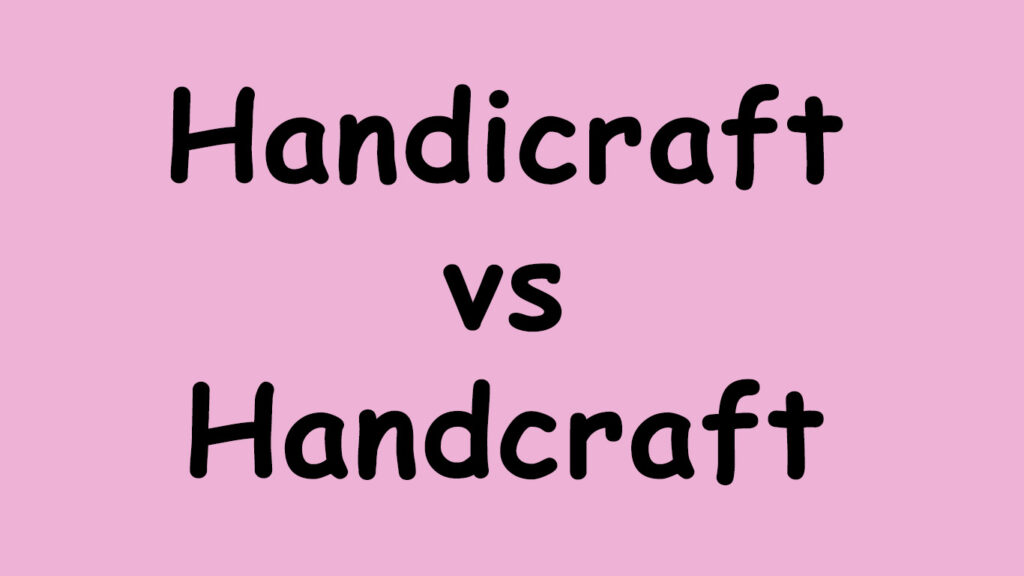
In today’s world, handcrafted items are gaining increasing recognition for their uniqueness, quality, and cultural significance. Whether you’re an art enthusiast, an artisan, or someone seeking a special gift, you may have come across the terms handicraft and handcraft. While they are often used interchangeably, there are notable differences between these two forms of craftsmanship. Understanding these differences can help you appreciate the artistry and value behind every handcrafted item.
In this article, we’ll explore the key differences between handicraft and handcraft, focusing on how both forms of craftsmanship contribute to the world of handcrafted items. We’ll also discuss why handcrafted items are so valued today and how they continue to impact modern design and sustainability.
What Are Handcrafted Items?
Handcrafted items are products made by hand, using traditional techniques and tools rather than machines. These items are often the result of skilled artisans’ work, who pour their creativity, time, and effort into each piece. The result is a handcrafted item that is unique, durable, and often one-of-a-kind. The process involves manual labor, which sets these products apart from mass-produced goods.
The History and Significance of Handcrafted Items
The practice of creating handcrafted items dates back thousands of years. In ancient cultures, artisans used their skills to create everyday objects, clothing, and art. These handcrafted items were often more than just functional—they told stories of the cultures that created them. For example, handcrafted pottery and handwoven textiles have been vital to various societies, symbolizing not just utility but also beauty and heritage.
Today, people continue to appreciate the authenticity and charm of handcrafted items. The modern consumer is increasingly drawn to products that offer a personal touch and reflect the individuality of the artisan. Whether it’s a handcrafted leather wallet or a handcrafted wooden table, these items add uniqueness and character to your home and life.
Explore a curated collection of handcrafted items that celebrate skill and creativity at Sigma HandiCraft.
What Is Handcraft? The Modern Twist on Traditional Craftsmanship
While handcrafted items encompass traditional arts, handcraft refers to the creation of functional or decorative items made entirely by hand, but with more modern influences. Handcraft can involve a mix of traditional techniques and contemporary design, resulting in pieces that are often innovative and artistic.
Modern Handcrafts: Innovation Meets Tradition
In the world of handcraft, artisans blend traditional methods with new materials and ideas. For example, handcrafted jewelry today may incorporate contemporary styles, combining precious metals with modern gemstones or unconventional materials like recycled items. The artistry of handcraft allows for greater creativity, and as such, these items can be found in galleries, exhibitions, and design showcases.
What sets handcraft apart is its emphasis on personal creativity and unique design. While traditional handcrafted items are steeped in cultural heritage, handcraft focuses on pushing the boundaries of style and technique.
Key Differences Between Handicraft and Handcraft
Even though handicraft and handcraft are both forms of craftsmanship, they differ in various aspects. Let’s take a look at the most important distinctions.
1. Traditional vs. Contemporary Approach
Handicraft is rooted in tradition. It refers to items made using techniques passed down through generations. These handcrafted items often hold cultural significance and reflect the values and practices of a particular region or group of people. In contrast, handcraft can incorporate modern materials and design techniques, focusing on innovation and personal creativity while still maintaining craftsmanship.
2. Functional vs. Decorative
Many handcrafted items are primarily functional, such as handcrafted furniture, clothing, or tools. These objects serve an important purpose but also carry artistic value. On the other hand, handcraft often includes decorative items like art pieces, modern jewelry, and design objects that blend form and function.
3. Cultural Heritage vs. Artistic Expression
While handicraft is deeply tied to cultural heritage and traditions, handcraft is more about personal expression and the designer’s unique voice. Both create beautiful and valuable products, but the focus differs: handicraft aims to preserve history, while handcraft is often more about innovation.
Why Are Handcrafted Items So Valuable?
The growing appreciation for handcrafted items can be attributed to several key factors. In a world dominated by mass production, handcrafted items stand out for their authenticity, quality, and artistry.
1. The Support of Local Artisans
When you purchase handcrafted items, you are supporting local artisans and small businesses. These artisans often rely on their craft for their livelihood. By choosing handcrafted items, you are helping sustain traditional skills and ensuring that artisans can continue creating their work.
2. Sustainability and Eco-Friendliness
Many handcrafted items are made using natural, recycled, or upcycled materials. This makes them an environmentally friendly choice compared to mass-produced items. By purchasing handcrafted goods, you are supporting sustainable practices and contributing to reducing the environmental impact of fast fashion and mass production.
3. One-of-a-Kind Pieces
Every handcrafted item is unique. Unlike mass-produced goods, no two handcrafted products are exactly the same. Whether it’s a handcrafted ceramic mug or a handwoven blanket, these items have personality, charm, and an individual touch that mass-produced items can never replicate.
4. Connection to Craftsmanship
When you buy a handcrafted item, you’re not just purchasing a product; you’re acquiring a piece of the artisan’s creativity, passion, and skill. These items represent the time and effort the maker has invested, making them far more meaningful than factory-made alternatives.
Conclusion: Embrace the Beauty of Handcrafted Items
In conclusion, the terms handicraft and handcraft represent two sides of the same coin—craftsmanship that is made with skill, care, and dedication. Whether it’s handcrafted items rooted in tradition or handcraft pieces reflecting modern artistry, both forms of craftsmanship offer immense value in today’s world. They provide consumers with a way to connect with unique and creative products while supporting local artisans and sustainable practices.
If you’re in search of authentic, high-quality handcrafted items, be sure to explore Sigma HandiCraft, where you’ll find a curated selection of one-of-a-kind pieces crafted with love and skill.
